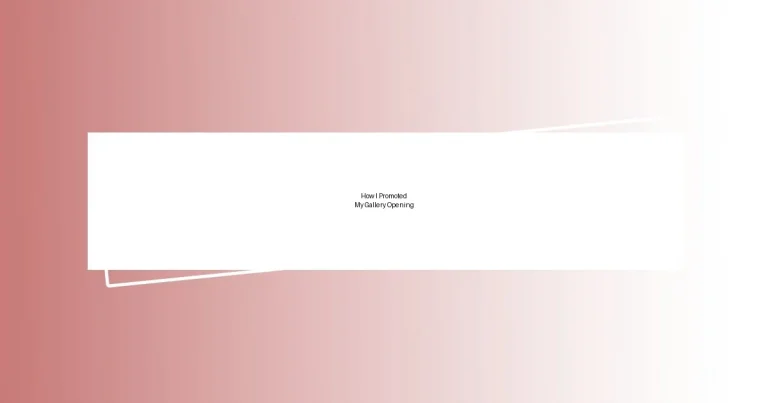Key takeaways:
- Effective promotion is essential for artists to connect with their audience and generate excitement around their work.
- Identifying and understanding the target audience helps tailor promotional strategies and fosters stronger connections.
- Engaging and creatively designed invitations can significantly enhance audience interest and attendance.
- Collaborating with local influencers and hosting pre-opening events can amplify reach and create meaningful community interactions.
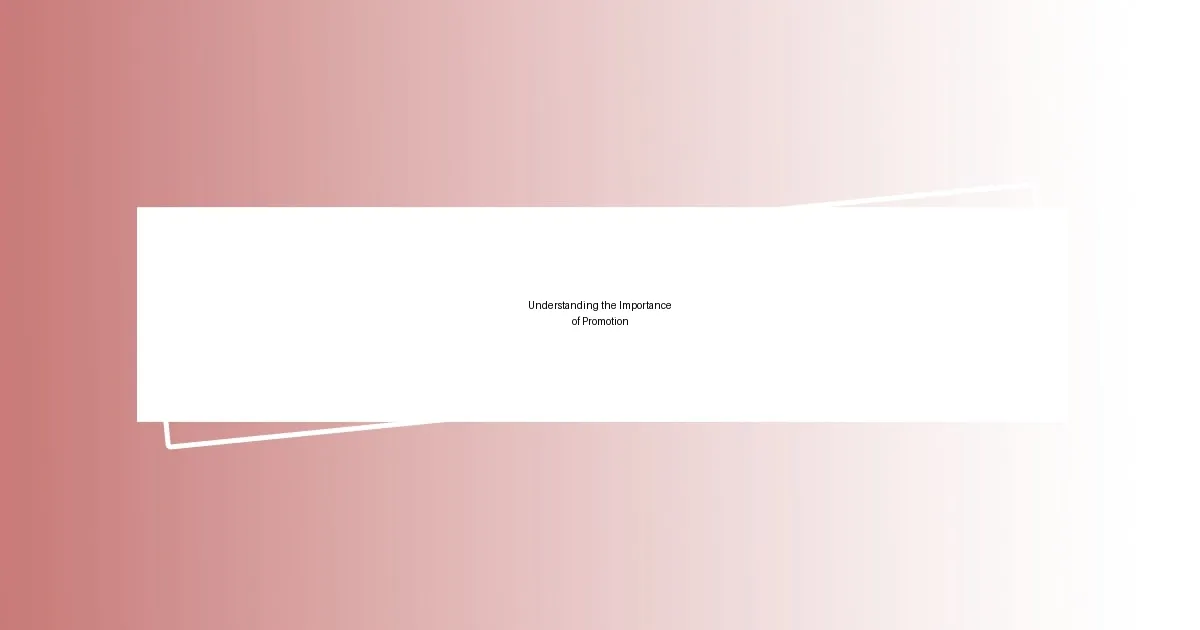
Understanding the Importance of Promotion
Promotion is more than just a checkbox on a to-do list; it’s a bridge that connects your passion with an audience eager to experience it. I remember the nervous energy I felt leading up to my gallery opening, knowing that without effective promotion, all my hard work could go unnoticed. Have you ever put your heart into a project only to realize nobody knew about it? That’s the fear that drives many artists to truly invest in their promotional efforts.
From social media campaigns to local outreach, every effort counts. I once created a buzz by collaborating with a local coffee shop, where I showcased a few pieces while their patrons sipped their lattes. The coffee shop owner shared my posts, effectively doubling my reach. That small partnership taught me how community collaboration can amplify your voice and bring in an audience you might not have reached alone.
What I’ve learned over time is that promotion ignites excitement and anticipation. For my last opening, I felt the thrill of gathering a crowd only because I shared sneak peeks and behind-the-scenes content leading up to the event. It transformed my opening into a shared experience rather than a solitary celebration. Don’t underestimate the power of building a community around your work; it can make all the difference.
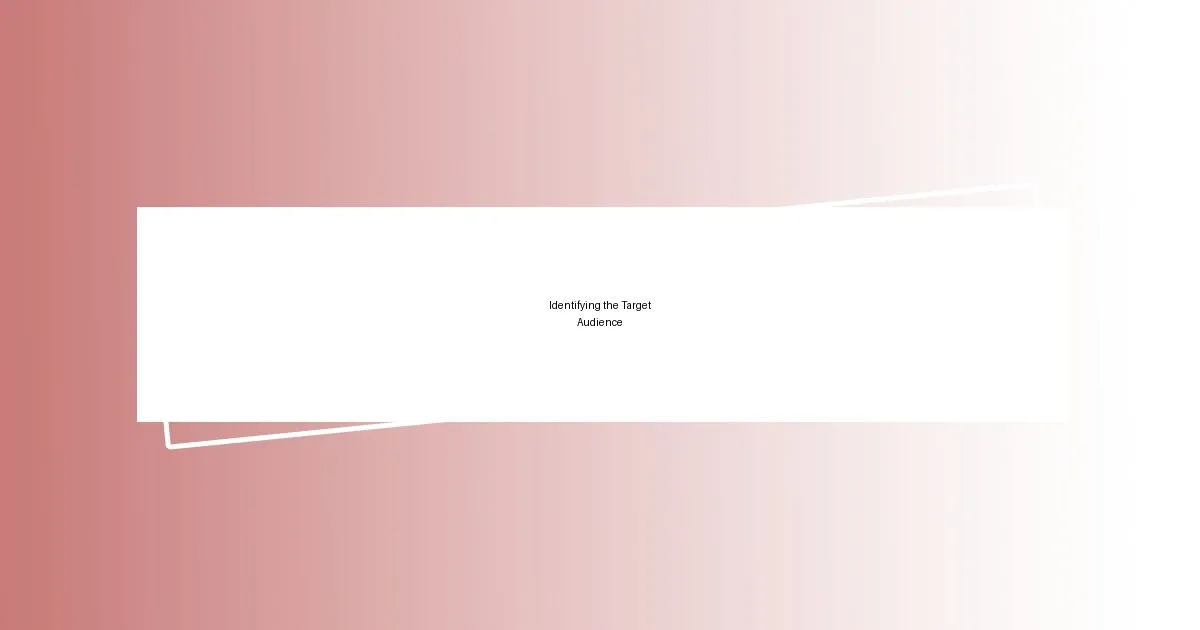
Identifying the Target Audience
Identifying the target audience is a critical step you can’t overlook. Think about who you want to reach—is it local art lovers, collectors, or even families looking for weekend activities? I’ve found that having a clear picture of my audience helps tailor my promotional strategies effectively. For instance, I once assumed my work would resonate primarily with fellow artists, but I was pleasantly surprised to see that families and young professionals were equally interested after I adjusted my messaging.
To help visualize this process, I created a simple comparison table during my planning phase. It highlighted different audience segments and their specific interests, allowing me to focus my marketing efforts where they would be most impactful. I remember sitting down one evening, sketching out these categories and feeling a spark of clarity as I understood who would appreciate my art the most. Engaging with these segments in a way that feels personal can lead to stronger connections.
Connecting with my audience doesn’t just inform my marketing; it also inspires my work. One time, I hosted a feedback session with local art enthusiasts, which opened up a dialogue about themes they felt were relevant. This not only made my upcoming exhibition more relatable but also fostered a sense of shared ownership over the experience. Understanding who you’re talking to can transform your promotional efforts into genuine conversations.
| Audience Segment | Interests |
|---|---|
| Local Art Lovers | Unique pieces, community events |
| Collectors | Investment potential, exclusivity |
| Families | Aesthetics, educational experiences |
| Young Professionals | Trendy designs, social events |
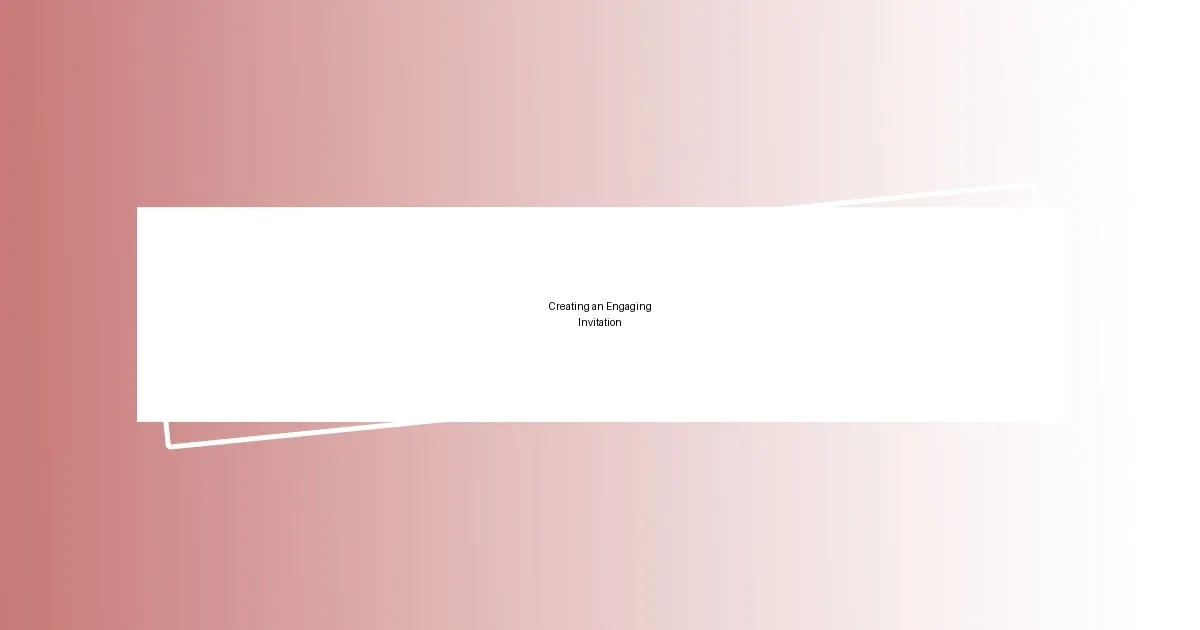
Creating an Engaging Invitation
Creating an inviting and engaging invitation is an art in itself. I vividly recall the moment I designed the invitation for my last gallery opening; it felt like laying down the first brushstrokes on a canvas. I used vibrant colors and bold fonts that reflected the atmosphere I wanted to create—energetic and welcoming. The actual physical invitations were enhanced with a texture that could be felt and appreciated, encouraging recipients to engage with the artwork before stepping foot in my gallery.
To make your invitation truly stand out, consider these elements:
- Visuals: Use eye-catching imagery that corresponds to the theme of your gallery. The right visual will resonate with the audience and capture their attention.
- Personal Touch: Write a personalized note for select friends and influencers. A heartfelt message can turn a simple invitation into something memorable.
- Clear Details: Make sure essential information, like date, time, and location, is easy to find. Clarity prevents any confusion and ensures your audience knows how to join you.
- Call to Action: Encourage RSVPs or let them know the first 20 attendees will receive a small art gift. This adds an element of excitement and exclusivity.
- Digital and Physical: Consider sending both digital invites through email and physical ones through the mail. Different methods reach different audiences, expanding your reach.
Infusing emotion into your invitations can significantly impact response rates. I remember adding a short poem inspired by the theme of my exhibition, which sparked curiosity and a connection, inviting guests not just to an event but to an experience. After all, your invitation is the first taste of what’s to come, and it should leave them eager for more.
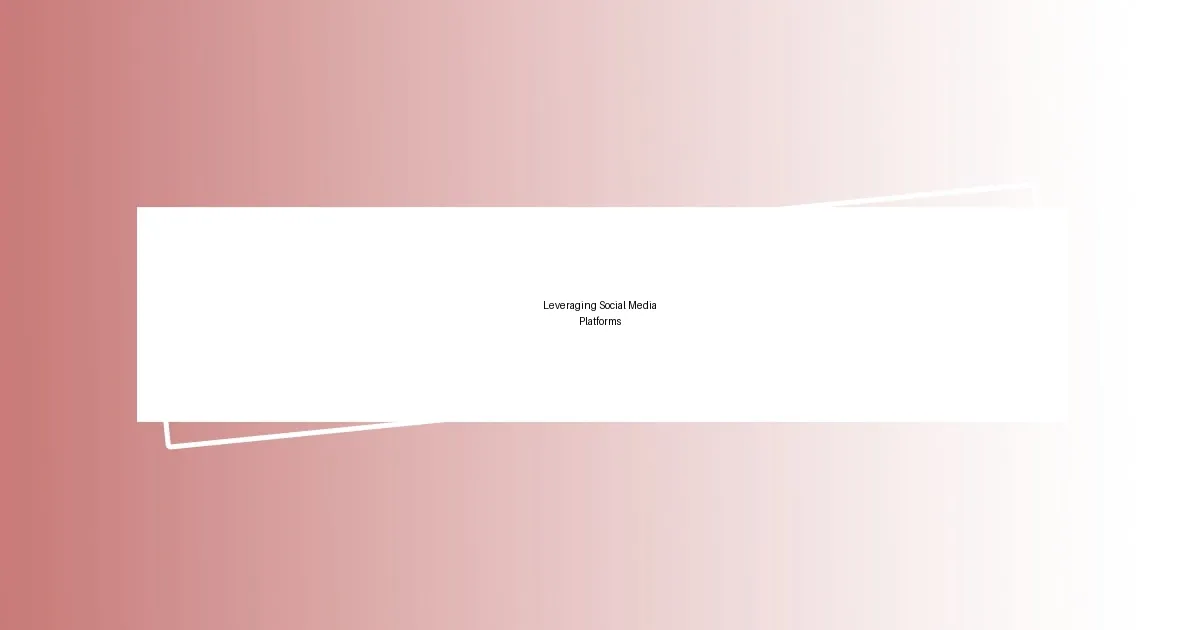
Leveraging Social Media Platforms
When it comes to leveraging social media platforms for my gallery opening, I’ve learned that consistency is key. I developed a content calendar that laid out daily posts leading up to the event. Each post brought a new angle—whether it was behind-the-scenes preparation, featured artwork, or highlights of what attendees could expect. I remember one evening, sitting on my couch, scrolling through posts that had genuinely connected with my audience; seeing likes and comments was affirming and showed me that my approach resonated. How often do we underestimate the power of a well-timed post?
Engagement is more than just broadcasting information; it’s about creating conversations. I vividly recall launching a poll on Instagram Stories asking followers which artwork they were most excited to see. The responses flooded in, and it felt incredible to know that my community had a say in the experience! This not only helped build anticipation but also allowed me to emphasize those pieces during the opening. Isn’t it amazing how a simple question can transform an audience from passive observers to active participants?
Another strategy that worked wonders was hosting a virtual tour of my setup. I went live on Facebook, giving viewers a sneak peek of my gallery just hours before the doors opened. The excitement from both my audience and myself was palpable as I shared the journey of each piece. I couldn’t help but feel a thrill when a viewer commented, “I wish I could be there!” That emotional connection made me realize that social media is more than just a promotional tool—it’s a platform for genuine interactions and building a supportive community around my art. Isn’t that what we’re all striving for as artists?
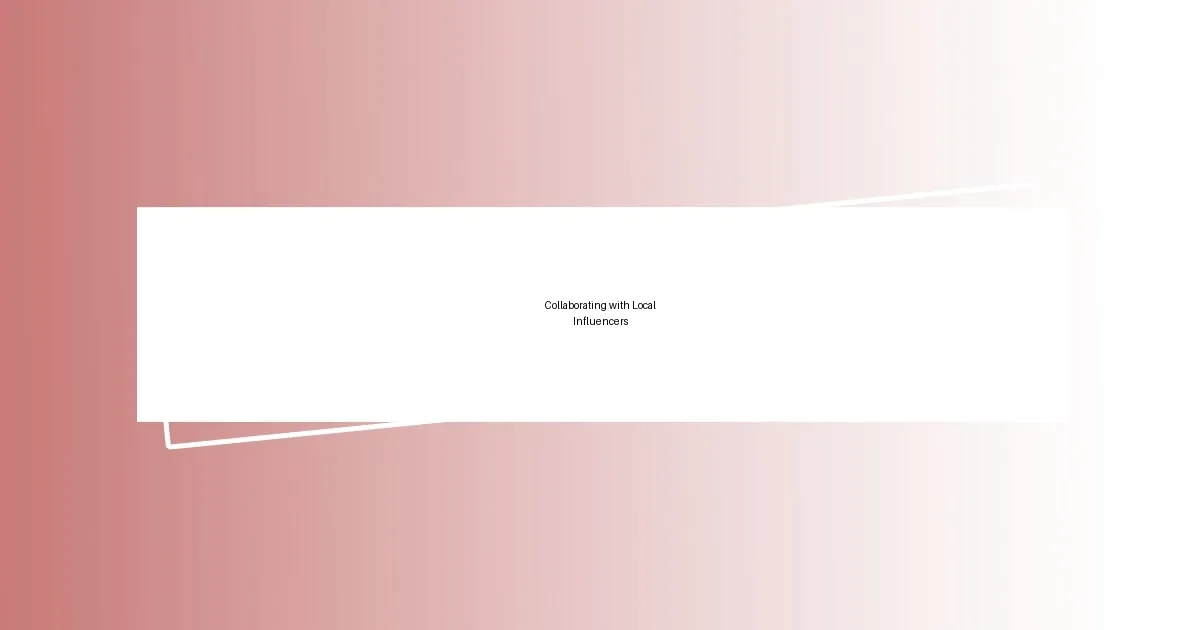
Collaborating with Local Influencers
Collaborating with local influencers was a game-changer for my gallery opening. I remember reaching out to a regional art blogger whose work I admired. After chatting over coffee, we discovered shared passions not just for art, but for engaging the community through creative events. They ended up promoting my opening on their blog, and the results were astounding. It felt incredible to see their audience resonate with my work, creating an intersection between their followers and my art.
The key to successful collaboration is mutual benefit. I offered them exclusive previews of my artwork and a behind-the-scenes look at my creative process. This approach fostered a genuine connection. In return, they shared heartfelt posts that highlighted not just my art, but the story behind it. I still think back to the moment one of their followers commented, “This piece speaks to me!”—reminding me of the power of storytelling in art. Isn’t it empowering to see your work touch others through a trusted voice?
I also made it a point to invite these influencers to my gallery opening, ensuring they felt appreciated. Their presence added a layer of excitement to the event. Watching them interact with attendees, snapping photos, and sharing live updates made the evening feel even more special. I couldn’t help but smile when I realized that this collaborative spirit brought together diverse audiences, weaving a richer narrative around my exhibition. What more could an artist ask for than to share an experience that genuinely engages the community?
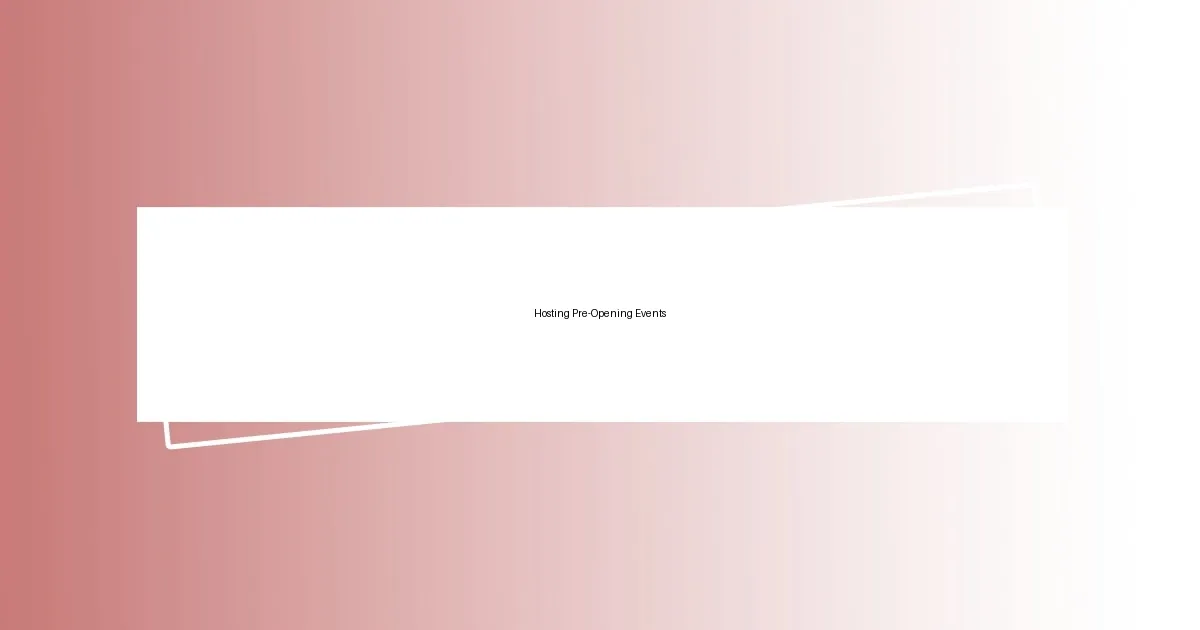
Hosting Pre-Opening Events
When I decided to host pre-opening events, the excitement was palpable. I organized an intimate preview night for close friends and fellow artists, and it turned out to be a fantastic opportunity to gather feedback. As I watched attendees share their thoughts about my work, I realized the value of their insights. It’s fascinating how fresh eyes can bring new perspectives to pieces that I’d spent countless hours perfecting, isn’t it?
I also tried my hand at workshops leading up to the opening. I recall one particular session where I invited a small group to join me in discussing the inspiration behind my latest pieces. The conversation flowed effortlessly, and I could feel the energy shift as everyone began to share their own artistic journeys. It was a reminder that art is not just about the displayed pieces but also about the connections we foster through the creative process. Can you think of a time when sharing your passion transformed a simple event into a memorable experience?
One of my favorite events was a “meet the artist” night, where guests could enjoy wine and snacks while walking through the gallery. I remember excitedly chatting with attendees about the stories behind each artwork, and seeing their eyes light up when they connected with a specific piece. That night solidified for me the importance of creating personal connections; it was heartening to witness the joy art can bring, and it made me wonder: how often do we take the time to engage in such meaningful conversations about creativity?
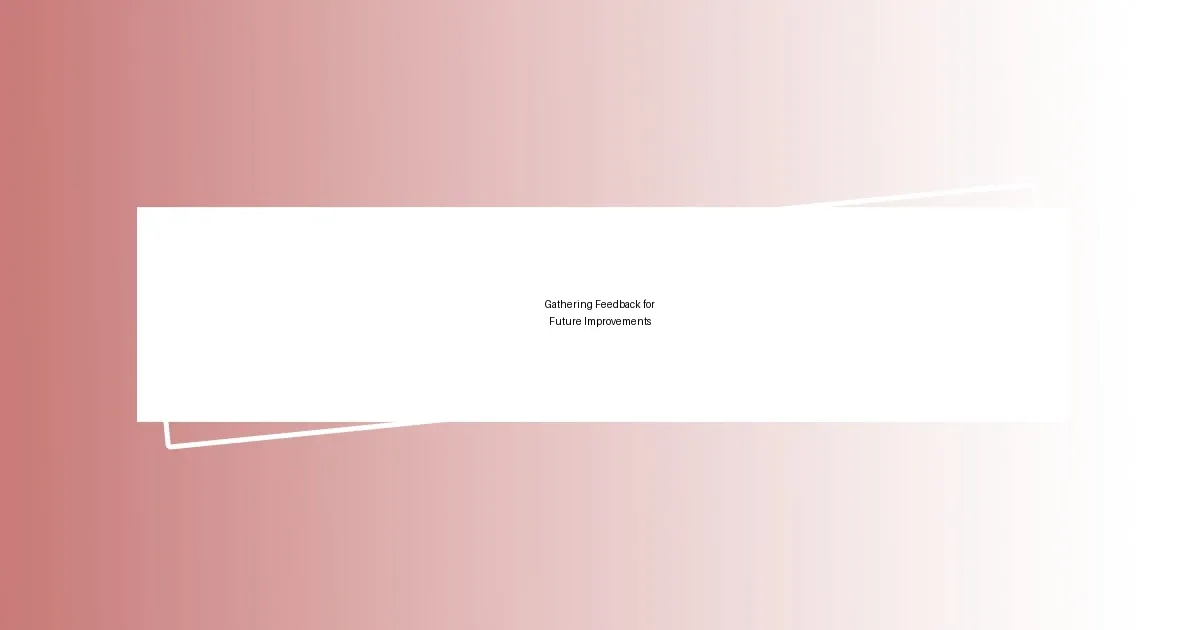
Gathering Feedback for Future Improvements
Gathering feedback after my gallery opening was an enlightening journey. I recall sending out a simple survey to attendees a few days later, asking what resonated with them the most. The variety of responses was astounding, with some highlighting specific artworks while others emphasized the overall ambiance of the gallery. It made me realize that people experience art differently, sparking a deeper desire in me to explore those diverse perspectives.
During the event, I made sure to engage with visitors directly, asking a few open-ended questions. I can’t forget one conversation with an older gentleman who explained how a particular piece reminded him of his late wife. Hearing stories like his created a heartfelt connection that extended beyond mere feedback—it was a reminder of the emotional impact art can have. Does it ever fascinate you how art can connect us across generations and experiences?
Reflecting on the feedback helped me identify areas for growth. One suggestion was to incorporate more interactive elements into my exhibitions. That struck me as an exciting opportunity. I began brainstorming ways to invite people to not just view art, but live it—perhaps through installations that invite community participation. I’m curious, how do you think interactive experiences can transform our perception of art?












